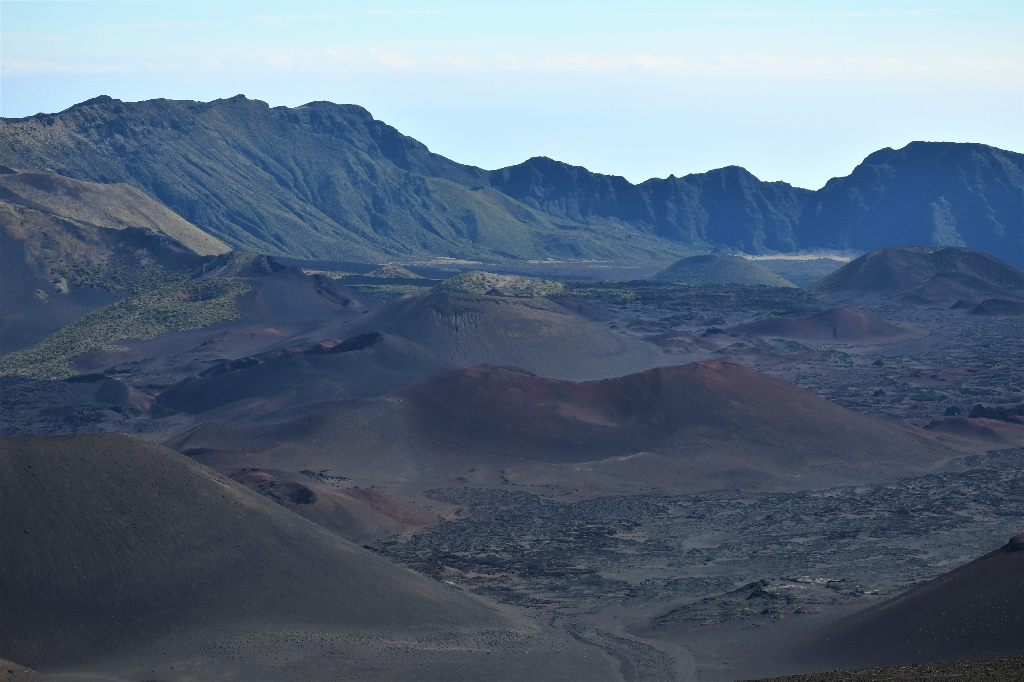
Standing next to the Haleakalā Visitor Center, behind the railing, you are on the edge of a deep, oddly shaped valley. In your opinion, which letter of the alphabet best matches the shape of the depression before you?
If the weather is clear, you can see straight across the Haleakalā Crater. The name Haleakalā Crater is historic, but it’s not a true crater or caldera. This “crater” shape is actually an erosional valley carved by water, not by a big explosion - that’s why its shape is more like an “S” or a “W” than a perfect “O”.
Look for two large river-carved valleys on each side of the volcano- they intersect the crater at Ko'olau Gap to the north and Kaupō Gap to the east. Over hundreds of thousands of years, flowing water in these valleys cut upstream until they coalesced to form the summit depression. Over the last several thousand years, mildly explosive volcanic eruptions have filled and flattened the bottom of the originally V-shaped valley, shaping the present-day flat crater floor and marking it with the red and black scoria cone puʻu (hills) that you see.
The inside of the crater is filled a riot of colors. Black, red, orange, yellow, grey, and green swirl across lava flows and over cinder cones. The orange and green are mostly signs of vegetation growing among the rocks, and the variation from red to black is largely due to different amounts of oxidation, or rust, of the iron contained in the basaltic lava and cinder. Oxidation can vary within a single eruption, caused by different amounts of water vapor in the melt coming up to the surface, or change over time due to weathering–exposure to air, precipitation, and harsh ultraviolet radiation from the sun.
Just like the red rocks, your red (oxygenated) blood also contains oxidized iron, mostly in your red blood cells and muscle tissues. It’s necessary to transport oxygen to your lungs, a function that is put to the test at this elevation. Before this mountain’s summit eroded into the crater you see below, the extra several thousand feet of elevation would have made the air feel even thinner!
If the weather is clear, you can see straight across the Haleakalā Crater. The name Haleakalā Crater is historic, but it’s not a true crater or caldera. This “crater” shape is actually an erosional valley carved by water, not by a big explosion - that’s why its shape is more like an “S” or a “W” than a perfect “O”.
Look for two large river-carved valleys on each side of the volcano- they intersect the crater at Ko'olau Gap to the north and Kaupō Gap to the east. Over hundreds of thousands of years, flowing water in these valleys cut upstream until they coalesced to form the summit depression. Over the last several thousand years, mildly explosive volcanic eruptions have filled and flattened the bottom of the originally V-shaped valley, shaping the present-day flat crater floor and marking it with the red and black scoria cone puʻu (hills) that you see.
The inside of the crater is filled a riot of colors. Black, red, orange, yellow, grey, and green swirl across lava flows and over cinder cones. The orange and green are mostly signs of vegetation growing among the rocks, and the variation from red to black is largely due to different amounts of oxidation, or rust, of the iron contained in the basaltic lava and cinder. Oxidation can vary within a single eruption, caused by different amounts of water vapor in the melt coming up to the surface, or change over time due to weathering–exposure to air, precipitation, and harsh ultraviolet radiation from the sun.
Just like the red rocks, your red (oxygenated) blood also contains oxidized iron, mostly in your red blood cells and muscle tissues. It’s necessary to transport oxygen to your lungs, a function that is put to the test at this elevation. Before this mountain’s summit eroded into the crater you see below, the extra several thousand feet of elevation would have made the air feel even thinner!
Is there something we missed for this itinerary?
Itineraries across USA

Acadia

Arches National Park

Badlands

Big Bend

Biscayne

Black Canyon Of The Gunnison

Bryce Canyon

Canyonlands

Capitol Reef

Carlsbad Caverns

Channel Islands

Congaree

Crater Lake

Cuyahoga Valley

Death Valley

Dry Tortugas

Everglades

Gateway Arch

Glacier

Grand Canyon

Grand Teton

Great Basin

Great Smoky Mountains

Guadalupe Mountains

Haleakalā

Hawaiʻi Volcanoes

Hot Springs

Indiana Dunes

Isle Royale

Joshua Tree

Kenai Fjords

Kobuk Valley

Lassen Volcanic

Mammoth Cave

Mesa Verde

Mount Rainier

North Cascades

Olympic

Petrified Forest

Pinnacles

Rocky Mountain

Saguaro

Shenandoah

Theodore Roosevelt

Virgin Islands

Voyageurs

White Sands

Wind Cave

Yellowstone

Yosemite

Zion